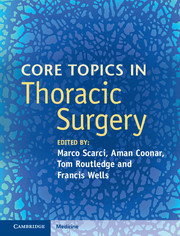Book contents
- Frontmatter
- Contents
- List of contributors
- Section I Diagnostic work-up of the thoracic surgery patient
- Section II Upper airway
- Section III Benign conditions of the lung
- Section IV Malignant conditions of the lung
- Section V Diseases of the pleura
- Section VI Diseases of the chest wall and diaphragm
- Section VII Disorders of the esophagus
- 23 Benign esophageal disease
- 24 Esophageal cancer
- 25 Esophageal perforation
- Section VIII Other topics
- Index
- References
24 - Esophageal cancer
from Section VII - Disorders of the esophagus
Published online by Cambridge University Press: 05 September 2016
- Frontmatter
- Contents
- List of contributors
- Section I Diagnostic work-up of the thoracic surgery patient
- Section II Upper airway
- Section III Benign conditions of the lung
- Section IV Malignant conditions of the lung
- Section V Diseases of the pleura
- Section VI Diseases of the chest wall and diaphragm
- Section VII Disorders of the esophagus
- 23 Benign esophageal disease
- 24 Esophageal cancer
- 25 Esophageal perforation
- Section VIII Other topics
- Index
- References
Summary
Surgical anatomy
The esophagus begins at the level of the cricopharyngeus or upper esophageal sphincter (UES) and descends in the posterior mediastinum, through the esophageal hiatus at the level of T10, to join the stomach. In the absence of a hiatal hernia, the gastroesophageal junction lies 2–4 cm below the esophageal hiatus. Important relations of the esophagus anteriorly are the trachea from the level of the UES to the tracheal carina at T4, which is approximately 25 cm from the incisor teeth endoscopically, the left main bronchus. Below T4/5, the heart, specifically the left atrium, and inferior pulmonary veins lie anterior to the esophagus. Posteriorly lie the aorta and spine and laterally the lungs, the azygous vein, and thoracic duct. Understanding the anatomic relations is important in considering treatment because these structures may be invaded by an esophageal tumor or may be injured during esophagectomy.
The esophagus consists of a mucosal layer, a circular muscle layer, and a longitudinal muscle layer. It lacks a serosa. The lymphatics of the esophagus originate in the submucosal layer and have both indirect and direct connections to longitudinal lymphatic channels and the thoracic duct. The longitudinal lymphatic channels allow for extensive proximal and distal spread of cancer cells. This anatomic feature allows for extensive intramural spread of cancer as well as early dissemination of esophageal cancer once the tumor breaches the lamina propria and invades the submucosa. Because of potential intramural spread, proximal resection margins of 5–10 cm are required when performing an esophagectomy in order to achieve an R0 resection.
The esophagus is lined by squamous epithelium; however, it may acquire a columnar lining in response to chronic severe gastroesophageal reflux. This metaplastic epithelium, Barrett's esophagus, may develop dysplastic changes, which then progress to adenocarcinoma. Thus there are two dominant histologies in esophageal cancer: squamous cell carcinoma and adenocarcinoma. However, other malignancies may also occur as primary tumors in the esophagus, including small cell carcinoma, melanoma, carcinosarcoma, leiomyosarcoma, angiosarcoma, granular cell tumor, and lymphoma.
- Type
- Chapter
- Information
- Core Topics in Thoracic Surgery , pp. 234 - 239Publisher: Cambridge University PressPrint publication year: 2016



